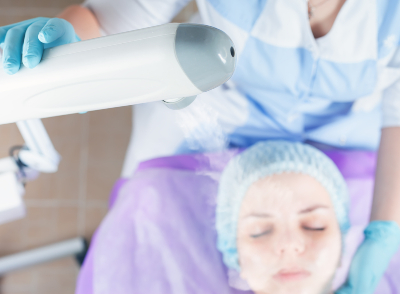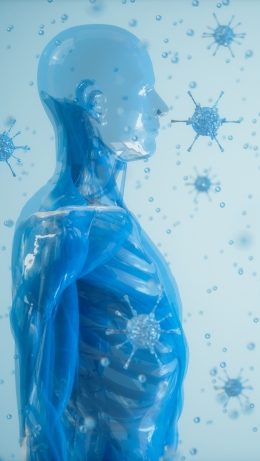 HAVE A QUESTION FOR DR. TESSA?
HAVE A QUESTION FOR DR. TESSA?
Email her your question at askdrtessa@ascpskincare.com.
 Q: Should I be concerned about using my steam machine on clients? I don’t want to be blowing virus particles directly into their face!
Q: Should I be concerned about using my steam machine on clients? I don’t want to be blowing virus particles directly into their face!
A: If either you or your client has COVID-19, the close interaction for a prolonged period of time with minimal ventilation is a prime opportunity for transmission of the virus. The additional exposure posed by use of a steamer would certainly not help matters, but the extent to which steam would cause transmission of the virus beyond the extended interaction (greater than 20 minutes) in close proximity in a poorly ventilated area, is unfortunately unknown.
 Let’s review how the virus spreads. When someone is infected with COVID-19, the majority of viral particles that they shed, or release from their body, come in the form of larger respiratory droplets (greater than 5 micrograms). These larger droplets remain in the air for a short time and travel only short distances, generally less than 1 meter. The rationale behind cloth face masks is to capture these large droplets and prevent them from traveling in the air. However, your clients may not be wearing a face mask during the entirely of their service, compromising this line of defense. Another way infected individuals spread the virus is through small (less than 5 micrograms), aerosolized, virus-laden droplets released when they speak, breathe, sneeze, or cough. These particles can remain in the air for greater periods of time and can travel longer distances—greater than 1 meter. This is the route of transmission that non-respirator face masks can’t mitigate (the particles are too small to be captured by the mask).
Let’s review how the virus spreads. When someone is infected with COVID-19, the majority of viral particles that they shed, or release from their body, come in the form of larger respiratory droplets (greater than 5 micrograms). These larger droplets remain in the air for a short time and travel only short distances, generally less than 1 meter. The rationale behind cloth face masks is to capture these large droplets and prevent them from traveling in the air. However, your clients may not be wearing a face mask during the entirely of their service, compromising this line of defense. Another way infected individuals spread the virus is through small (less than 5 micrograms), aerosolized, virus-laden droplets released when they speak, breathe, sneeze, or cough. These particles can remain in the air for greater periods of time and can travel longer distances—greater than 1 meter. This is the route of transmission that non-respirator face masks can’t mitigate (the particles are too small to be captured by the mask).
While we are still in the early stages of understanding the nature of which types of infections contribute most to the spread, we know that symptomatic (infected individuals with symptoms of illness), pre-symptomatic (infected individuals who have not yet developed symptoms) and, likely asymptomatic (infected individuals who never develop symptoms), all contribute to its spread. The final way the virus is transmitted is on surfaces or, in epidemiologic terms, fomites—inanimate objects that are contaminated with viral particles.
I review this information because it presents several actions you can control and a few you can’t. You can make alterations to the service you provide to make it safer, but you can’t fundamentally change the nature of the service, which in our current situation, involves risk.
Actions you can take to reduce risk include:
- Pre-screening clients prior to their appointment and upon arrival using the processes described in the ASCP Back-to-Practice Guidelines. Pre-screening will identify symptomatic individuals or persons who have a known close contact with COVID-19 (potential pre-symptomatic or asymptomatic). In the pre-screening interaction, review expectations for the clients at your office (such as wearing a face mask at all times except when removal is necessary for treatment).
- Clean all surfaces between clients, first with soap and water, then with an EPA-approved disinfectant. Pay special attention to equipment that is used between clients (such as the steamer). This will address the fomite mode of indirect transmission.
- Wear a cloth face mask, or if you have access, a surgical face mask. It is important that you wash your hands before putting on your mask, don’t touch it once it is on, and remove it after your client leaves (washing your hands again). Use a fresh face mask for each client.
- Consider how to increase airflow in the room such as leaving the door open or placing a high-efficiency portable particulate air (HEPA) purifier in the room (turned to its maximum setting).
So, in summary, I’ve not straight-up told you not to use the steamer. We just don’t know yet if it truly poses a risk and I understand it may be an essential aspect of the service you provide. However, I’ve suggested that you double down on the actions we know can mitigate risk: pre-screening, cleaning, face masks, and ventilation.
For the latest in skincare education and industry updates, become an ASCP member.
ASCP DISCLAIMER:
 Please be sure to always work within your scope of practice as determined by your state and to adhere to all local and federal rules and regulations regarding COVID-19 protocols. To learn more about returning to your practice or to access free resources to assist you with reopening, access the ASCP Back-to-Practice Guide!
Please be sure to always work within your scope of practice as determined by your state and to adhere to all local and federal rules and regulations regarding COVID-19 protocols. To learn more about returning to your practice or to access free resources to assist you with reopening, access the ASCP Back-to-Practice Guide!
 About the Author:
About the Author:
Dr. Tessa Crume is an Associate Professor in the Epidemiology Department at the Colorado School of Health at the University of Colorado Anschutz Medical Campus. Her research focuses on the development and utilization of public health surveillance systems to understand the burden of disease. She has been an academic researcher since 2011, before which she worked for a decade as an applied epidemiologist at the state and federal level, analyzing surveillance data and evaluating public health impact. Dr. Crume has taught the core epidemiology class at the Colorado School of Public Health for nine years.
HAVE A QUESTION FOR DR. TESSA?
Email her your question at askdrtessa@ascpskincare.com.
- Log in to post comments

 Q: Should I be concerned about using my steam machine on clients? I don’t want to be blowing virus particles directly into their face!
Q: Should I be concerned about using my steam machine on clients? I don’t want to be blowing virus particles directly into their face! About the Author:
About the Author: